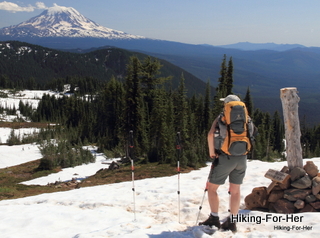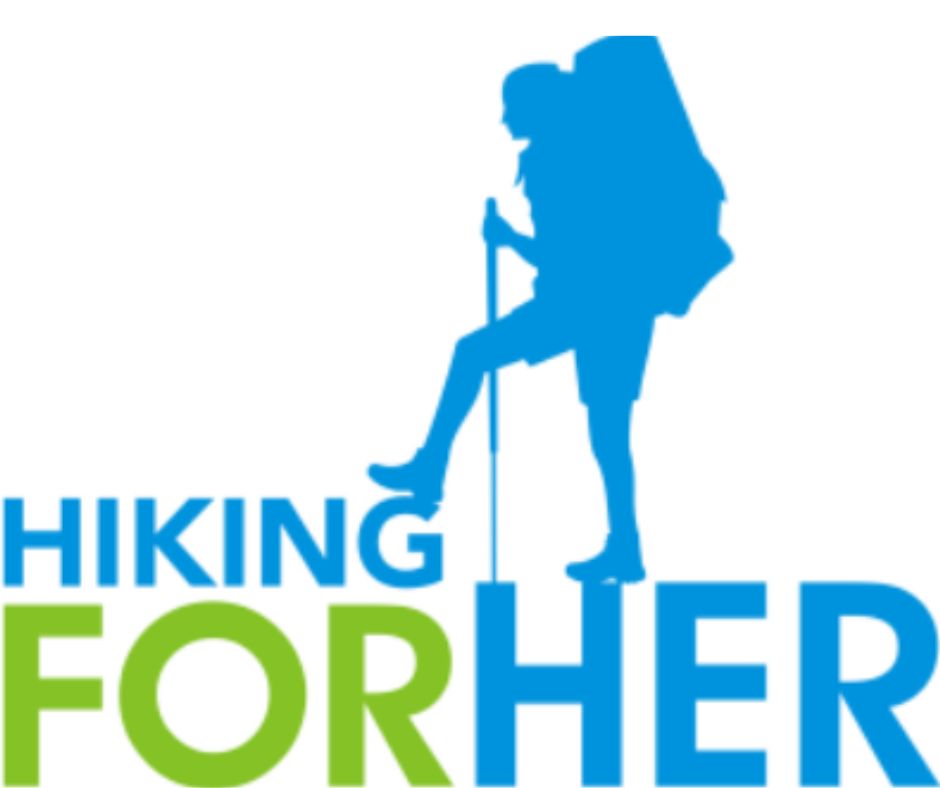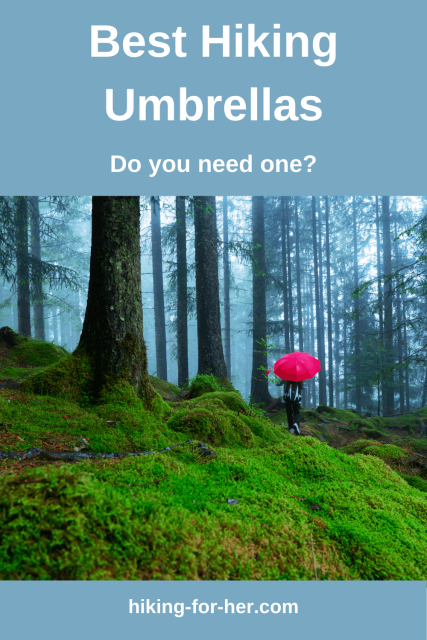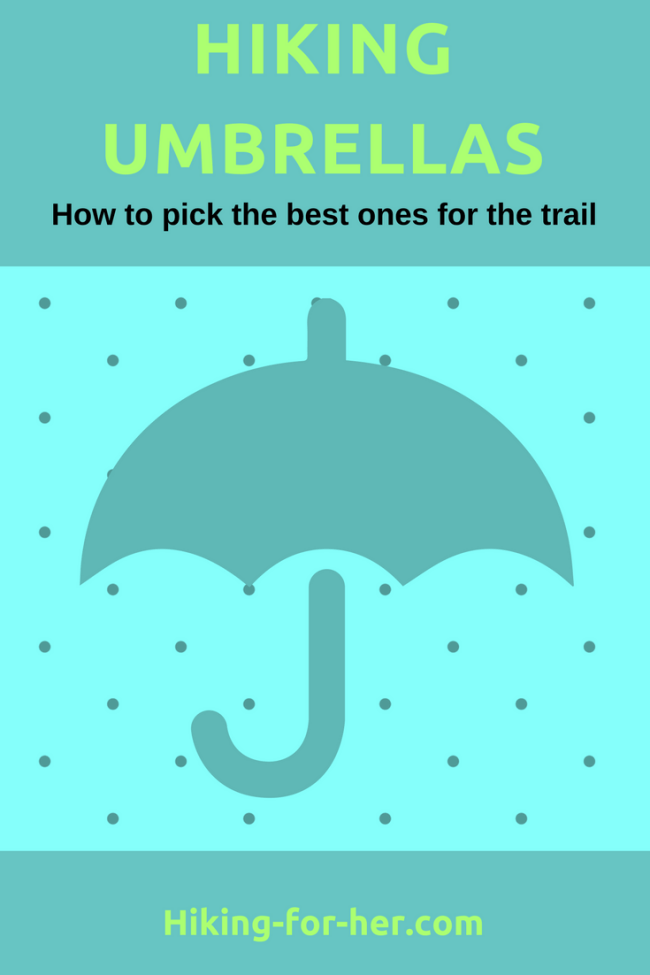Best Hiking Umbrellas:
Gotcha Covered On Your Hike!
By Diane Spicer
Choosing the best hiking umbrellas takes time, but since you're here, why not hang in there and learn all about them?
Or drop down to the topic that interests you most about this type of hiking gear.
Hikers need umbrellas??
The phrase "best hiking umbrellas" might bring to mind a warm summer shower, with hikers striding along muddy trails sporting colorful "bumbershoots".
But picture this:
A hiker on a hot, sun exposed trail winding through rocks and arroyos can use a hiking umbrella to protect head, face and upper body from excessive amounts of ultraviolet radiation.
- The "create your own shade" effect, with a nice side effect: less drain on your water supply.
- Technically, this type of protection would be called a parasol. Although "umbra" and shade go together, so go figure.
Or imagine a snow squall that catches a hiker by surprise. Hiking umbrella to the rescue!
Intrigued by these ideas?
Let's get a bit more specific about what to look for when taking an umbrella on a hike.
BTW, you're in good hands.
I live in Seattle, where we take our umbrellas, and our rain, seriously.
- In fact, every year we have a festival called Bumbershoot to glorify these fabric and frame contraptions :)
But first: the little known
hiking umbrella controversy
Right off the bat, let's identify which type of hiker you are in terms of using an umbrella on a hiking trail.
Option A
The hiker who claims "I am completely neutral on this subject".
- You've never even seen a hiker carrying an umbrella.
- Or if you have, you missed the whole kerfluffle over whether an umbrella is a valid piece of hiking gear.
- Either way, no umbrella on your hiking gear list. Yet.
Option B
The "Hiking umbrellas are a stupid idea and you'll never catch me carrying one on a hiking trail" hiker.
- Yes, an umbrella looks a bit silly when you're in the middle of nowhere on a sunny day.
- Yes, a hiking umbrella takes up space and adds weight to your pack.
- Yes, it's one more piece of hiking gear to keep track of and store somehow in your backpack.
So this hiker just skips the idea of best hiking umbrellas.
Option C
The "I can't live without my umbrella" hiker, who has figured out exactly which company makes the right one for her hiking style.
Read on for details about how to become this type of hiker. Or drop down now to find out my recommendations.
- Because I am happy to report that there are bomb proof hiking umbrellas which are lightweight and durable (some with a lifetime warranty).
- And will keep UV rays, tree detritus, and rain off your head and shoulders, which is the whole point, isn't it?
Anatomy of an umbrella for hikers
Let's quickly dissect an umbrella before we dive into a hiker's best hiking umbrellas criteria of weight, size, strength, portability, durability, and ease of usage.
Every umbrella, whether on trail or for running errands at home, has 4 main components:
Now let's put it all together:
The canopy is held open via the ribs and stretchers, and the entire overhead contraption is held in one hand by gripping the shaft in either hand.
Now you know!
Best hiking umbrellas:
6 features to consider
You want a trail worthy umbrella! Especially on a rainy day in strong winds.
So let's examine the features of the best hiking umbrellas which are worth paying for.
Weight of an umbrella
As a hiker, you don't want to carry heavy components made of metal or wood.
And you don't want cheap, easily broken or torn flimsy canopy materials or plastic, either.
Fiberglass ribs, nylon, and aluminum are materials to look for because not only are they light, they are weatherproof and strong.
- You want something weighing way less than a pound.
Umbrella sizing
The size is directly tied to the functions you expect your umbrella to perform for you on the trail.
- Do you want this piece of gear to keep sun off your shoulders?
- Are you anticipating its use as rain protection?
- As an impromptu wall to shield you during a pee stop or potty break in a treeless exposed area?
- Or do you plan to also use it as shelter, perhaps as an adjunct to your tarp system?
Choosing the right diameter means choosing one of those options. If you're fond of bubble umbrellas, that's one option.
A wider footprint is another option.
And I probably don't need to remind you that with size, comes weight.
Oops, I just did.
Strength
Ever have an umbrella fall to pieces just when you needed it most?
Yeah, not so much fun.
You want an umbrella that is not only the right size and weight, but as strong as the conditions you'll be hiking through.
- A collapsible umbrella will be less strong overall than one that does not compromise strength for portability.
But consider our next important feature.
Portability of your bumbershoot
Hikers want an umbrella that fits into, or is strapped onto, a backpack.
And therein lies a problem that you would do well to consider.
If you purchase a collapsible umbrella, it can be carried inside your backpack when you don't need it.
But if you will be facing day after day of high winds, snow dumps, fierce rain squalls, or some other rugged weather adventure, a collapsible umbrella will (wait for it...) collapse at inopportune moments.
- Never compromise your safety for portability.
Durability
The metal ribs will not be as durable and supportive if they have to bend to a smaller footprint.
That means if you're going to carry a hiking umbrella, make sure you buy one that is designed to stand up to wind, water, UV exposure, and more over many hiking seasons.
Second best: One that can be repaired with duct tape. Or still remains mostly functional when one part becomes compromised.
Ease of usage
Some umbrellas are real bears to get open if it's windy, especially if you have to wrestle it out of its holder before you can deploy it.
If you have any hand or wrist issues (previous injuries, missing digits, arthritis, or weakness), a one-button open/close spring system is what you need.
- Otherwise you'll be struggling with a manually operated umbrella with your cold, wet hands.
And make sure you can hold it comfortably in even the best of conditions.
- If the handle is too big for your hands (a real possibility for petite hikers), you won't want to use it.
- Or your sore hands the next day will actually prevent you from using it.
When does using a hiking umbrella
make sense?

Keeping your body thermoregulated is a big job.
You never know what the day will bring on a hiking trail: sun, snow, rain, hail, travel across hot rocks followed by snow fields, or a mix of all these.
Your clothing layering system is one way to tackle the job of keeping yourself warm/cool, dry and feeling strong.
- That includes UPF sun protective hiking clothing.
- And good rain gear.
But some might argue that having an umbrella can eliminate some of these hiking essentials.
Which weighs more, an umbrella or your rain gear?
Only you can do these calculations.
Note that if you hike in misty, damp places where the sun doesn't shine much and water doesn't fall straight down by the bucket load, an umbrella might not be as advantageous as rain pants and jacket.
But it would certainly provide more ventilation!
- Ever had it rain inside your jacket from your own sweat?
- And felt overheated as a result?
On the other hand, an umbrella is going to shield your upper body from sun, hail and rain more than a hat and a jacket with a hood would.
Pick your poison!
And if weight isn't an issue for you, you have the luxury of carrying both rain gear (jacket, pants, hat) and one of the best hiking umbrellas.
An umbrella as goat defense
Because I spend the majority of my trail time in the Pacific Northwest, I can think of one more use for a hiking umbrella: defending myself against an overly inquisitive mountain goat.
I've been in way too many situations where a male goat wants to be my buddy.
And I doubt many of them has seen or heard a hiking umbrella open at close range!
- The element of surprise can work in your favor.
- More tips on how to handle mountain goat encounters here
So instead of frantically using trekking poles to teach them what human personal space is all about, imagine yourself using an umbrella to define your perimeter.
But don't use it to poke at the goats, that annoys them into even worse behavior.

When using a hiking umbrella
could be counter-productive
Think of the most wind you have ever experienced in your life, perhaps on a ridgeline trail.
- Would an umbrella have been a liability?
- Would it have shredded even the best hiking umbrellas?
Now picture the most vegetation you've ever hiked through: jungle, rain forest, thick brush, blowdowns.
- Would the umbrella have slowed you down, or taken your attention off your footing as it tangled in the vegetation?
One more: Imagine the most torrential downpour or snow storm you would want to be hiking in. Liquid and/or solid water and wind coming sideways at you.
- Would an umbrella have been of any use at all?
Then go back to your moderate backpacking trips, and decide if packing a hiking umbrella makes sense for the terrain you enjoy.
A few more scenarios to consider
I'd also like to throw in a few more scenarios for debate on whether or not to carry one of the best hiking umbrellas.
A hiker who leaves rain gear at home, relying upon an umbrella for thermoregulation and dryness, is putting all eggs into one basket.
- What if the umbrella breaks?
- What if it gets left behind accidentally?
- Or a goat eats it ;)
If you routinely use trekking poles, you won't be using an umbrella.
Ditto for needing to use an ice axe for any length of time.
Even the best hiking umbrellas won't persuade you to give up your dexterity.
Unless you can lash it to your backpack strap, of course. Hold that thought!
Just for fun, an umbrella quote:
"I like to imagine the guy who invented the umbrella
was going to call it the ‘brella’.
But he hesitated.”
- Andy Field
Recommendations for the
best hiking umbrellas
There are a few worthy options created specifically for hikers, along with a whole universe of "regular" umbrellas.
Which is exactly why I took you through all of the components and scenarios a hiker might face:
- To give you a feel
for what to look for amongst the choices you will face as you shop for a hiking umbrella.
As a hiker, you want a sturdy, lightweight, durable, easy to use umbrella on the trail, and there are good choices to consider.
Six Moons Designs hiking umbrella
This well designed umbrella from Six Moons features a carbon fiber frame, EVA foam handle, and a small footprint.
At 6.8 ounces, you're not going to notice it in your backpack.
You can also purchase an attachment kit to keep your hands free on hikes.
Sea To Summit hiking umbrella
If you're planning to use an umbrella a lot in variable conditions, such as a thru hike or section hike where it's likely you will face gusts of wind, you'll want a compact umbrella with wind resistance.
Here's one of the best hiking umbrellas, by a company that I've used for waterproof stuff sacks and more:
Ready to give this
hiking technique a try?
Whether you call it an umbrella, a sunbrella, a parasol, or a bumbershoot, now you know how to pick the best one for your hiking needs.
And if I didn't say it before, the best hiking umbrellas are the ones that you see other hikers using.
- Don't be shy about asking someone on the trail why they have that particular umbrella in hand.
With or without an umbrella, be prepared for any type of hiking weather, and know how to stay safe, with these tips.
Home page > Best Hiking Gear >
Best Hiking Umbrellas
|
I get emails all the time about what I wear, eat, carry and love to use on the trail. That's
why I provide affiliate links to you: the best gear that I use myself and have seen used by other hikers is instantly
available for your consideration, and the gear company sends a few
pennies per dollar to this reader-supported hiking website. There is no added cost to you! Everyone ends up a winner: Great gear for you, strong gear companies, and more free hiking tips for everyone. Thanks very much for your support. It's warmly and sincerely appreciated. It also helps send these hiking tips to all your virtual trail buddies around the globe. |
 |




